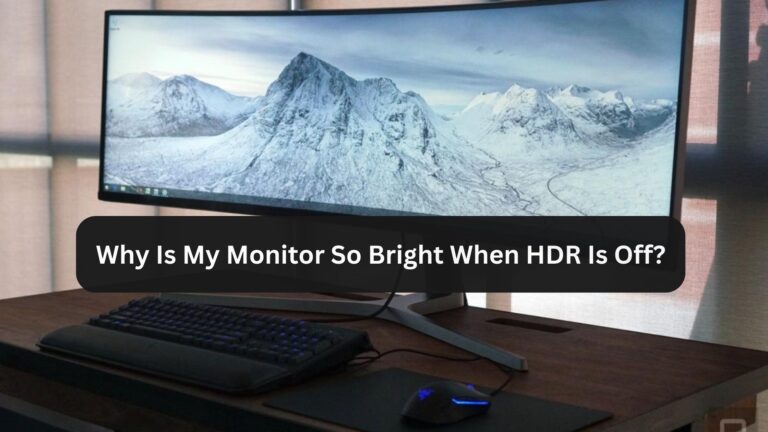Do Computer Monitors Emit Radiation? Understanding Safety and Risks
Many users wonder about the potential health risks associated with electronic devices, including the question, “Do computer monitors emit radiation?” With most of us spending hours in front of screens daily,
It’s important to understand what types of radiation, if any, computer monitors emit, and whether this poses a risk to your health. In this article, we’ll explore the types of radiation that may come from monitors, their potential impact, and how modern technology addresses these concerns.
Do Computer Monitors Emit Radiation?
Yes, computer monitors do emit radiation, but the type and amount of radiation are minimal and generally not harmful. There are two main categories of radiation:
- Ionizing radiation: High-energy radiation, like X-rays or gamma rays, which can be harmful in large amounts.
- Non-ionizing radiation: Low-energy radiation, like visible light and radio waves, which is emitted by many everyday devices, including computer monitors.
Computer monitors primarily emit non-ionizing radiation, which includes visible light and electromagnetic fields (EMFs). Modern monitors—such as LCD and LED displays—emit very low levels of EMF radiation that are generally considered safe.
Emit Radiation?
Yes, computer monitors emit non-ionizing radiation, including visible light and low levels of electromagnetic fields (EMFs). This type of radiation is considered safe for daily use and does not pose a significant health risk. Modern LED and LCD monitors emit far less radiation than older CRT models.
Types of Radiation Emitted by Computer Monitors
To understand the impact of radiation from monitors, it’s essential to know the types of radiation they emit and whether any pose a threat.
1. Electromagnetic Fields (EMFs)
Electromagnetic fields (EMFs) are produced by most electronic devices, including monitors. These fields are a form of non-ionizing radiation, meaning they do not carry enough energy to ionize atoms or molecules. The EMF radiation emitted by modern monitors is very low and within safe exposure limits as determined by health and safety organizations.
- CRT monitors (older cathode-ray tube monitors) emitted higher levels of EMF radiation compared to today’s LCD or LED monitors.
- Modern monitors are designed to meet stringent safety standards that limit EMF exposure, making them safer for long-term use.
2. Visible Light
Visible light is another form of non-ionizing radiation emitted by computer monitors. While visible light isn’t harmful in itself, extended exposure to bright screens can cause eye strain or discomfort, known as digital eye strain or computer vision syndrome (CVS).
- Blue light emitted by monitors has been linked to sleep disturbances and eye fatigue, but there are solutions, such as screen filters or software that reduces blue light exposure.
3. Low-Level Infrared Radiation
Monitors also emit small amounts of infrared (IR) radiation, which is part of the heat produced by the device. This radiation is not harmful to humans and is comparable to the infrared radiation emitted by other household electronics.
4. No Ionizing Radiation
Ionizing radiation, such as X-rays or gamma rays, is a harmful type of radiation that can damage cells and DNA. Computer monitors do not emit ionizing radiation, making them safe in terms of long-term radiation exposure.
Are Older CRT Monitors Riskier?
Older CRT (cathode-ray tube) monitors did emit higher levels of radiation compared to modern LCD and LED monitors. CRT monitors produced X-rays in very small amounts due to the cathode-ray process used to display images. However, even CRT monitors were designed with shielding to limit harmful radiation exposure.
- Modern monitors no longer use this technology and, therefore, do not emit X-rays or other harmful ionizing radiation.
- If you’re still using a CRT monitor, it might be time to consider upgrading to an LCD or LED display, which emits far less radiation and consumes less power.
Health Concerns Related to Computer Monitors
While computer monitors do emit radiation, the amount is extremely low and unlikely to cause health issues. However, there are a few concerns related to prolonged monitor use, including:
1. Digital Eye Strain (Computer Vision Syndrome)
One of the most common issues related to long-term computer use is digital eye strain, which can cause:
- Eye fatigue
- Headaches
- Dry or irritated eyes
This is not caused by radiation but by prolonged exposure to bright screens and blue light.
Solution:
- Take regular breaks using the 20-20-20 rule: Every 20 minutes, look at something 20 feet away for 20 seconds.
- Use blue light filters or software that reduces the amount of blue light emitted by your monitor.
2. Sleep Disruption Due to Blue Light
Monitors, like smartphones and tablets, emit blue light, which can interfere with the body’s production of melatonin, a hormone that regulates sleep.
Solution:
- Use a blue light filter or enable a night mode on your monitor during evening hours.
- Avoid screen use at least one hour before bedtime to help regulate sleep patterns.
3. Electromagnetic Sensitivity
Although the amount of EMF radiation emitted by modern monitors is low, some individuals report experiencing symptoms like headaches or fatigue due to EMF exposure. However, there is limited scientific evidence to support the idea that these low levels of EMF radiation can cause harm.
How to Minimize Exposure to Radiation from Monitors
While the radiation emitted by computer monitors is minimal and considered safe, there are steps you can take to reduce exposure:
1. Use Modern Monitors
Switch to an LCD or LED monitor, which emits less EMF radiation than older CRT monitors.
2. Maintain a Safe Distance
Position your monitor at least 20 to 30 inches away from your eyes to minimize exposure to both blue light and EMF radiation.
3. Take Breaks
Take regular breaks from your screen to reduce eye strain and limit extended exposure to EMF radiation.
4. Use Blue Light Filters
Install blue light filtering software or use physical screen filters to reduce the impact of blue light on your eyes and overall health.
FAQs About Whether Computer Monitors Emit Radiation
1. Do computer monitors emit harmful radiation?
No, modern computer monitors emit non-ionizing radiation, which is not harmful. The radiation levels from LCD and LED monitors are very low and safe for regular use.
2. Can the radiation from a computer monitor cause cancer?
There is no scientific evidence linking the non-ionizing radiation emitted by monitors to cancer. Ionizing radiation, which can be harmful, is not emitted by modern monitors.
3. Are older CRT monitors more dangerous than modern ones?
CRT monitors emitted higher levels of EMF radiation compared to modern LCD or LED monitors, but they were still within safety limits. However, upgrading to modern monitors reduces radiation exposure even further.
4. Can the blue light from my monitor harm my eyes?
Blue light from monitors can cause eye strain and disrupt sleep patterns, but it doesn’t cause permanent eye damage. Using blue light filters can help reduce its effects.
5. How can I protect my eyes from monitor radiation?
To reduce eye strain, follow the 20-20-20 rule, use blue light filters, and adjust your monitor’s brightness. Regular breaks from screen time can also help.
Conclusion
So, do computer monitors emit radiation? Yes, but the radiation they emit is non-ionizing and very low, making it generally safe for regular use.
Modern LCD and LED monitors emit far less radiation than older CRT monitors, and the amount of electromagnetic radiation and visible light they produce is well within safe limits.
While there are concerns about eye strain and blue light exposure, these can be easily managed with proper screen usage habits and protective measures.






